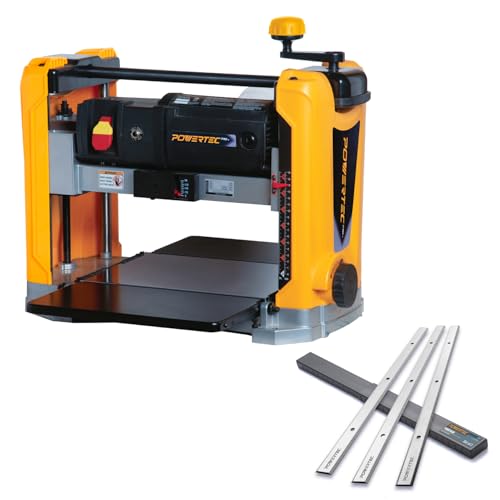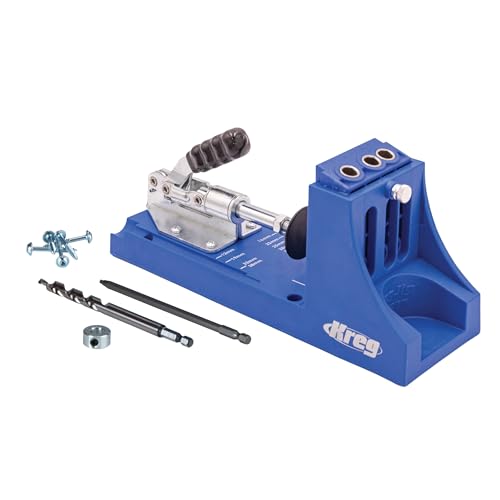POWERTEC PL1303C Planer Review: Cuts Tear-Out, Tames Snipe


POWERTEC’s PL1303C is a compact 13″ benchtop planer with a 15 A motor and three‑blade cutter head spinning at 9,400 RPM (28,200 CPM). It planes up to 6″ thick stock, offers 1/8″ depth steps, and includes adjustable infeed/outfeed tables to reduce tear‑out and tame snipe. Users should align tables, rotate blades, and hook a 4″ dust port to a vacuum. It’s solid for hobbyists; pros may want wider capacity. More specs and setup tips follow.
Main Points
- Three-blade cutter head reduces tear-out on hardwoods and delivers a smooth finish.
- Adjustable infeed/outfeed tables minimize snipe and tear-out when properly aligned.
- 15 Amp motor (9,400 RPM, 28,200 CPM) planes boards up to 6 inches thick for furniture and trim.
- Machined aluminum base and solid motor mount provide stability during operation; setup takes 15–30 minutes.
- Best for hobbyists and small shops seeking compact, reliable planing; professionals may prefer wider or two-speed models.
Quick Specs & Price Check
For those prioritizing cleaner workshops, models with effective dust collection are recommended in the Top Power Bench Planers list.Why This Product Stands Out

After checking specs and price, the POWERTEC PL1303C stands out by packing workshop-level performance into a portable benchtop unit.
Claim: it delivers power and precision in one package.
Evidence: a 15‑amp motor and three‑blade cutter reach 28,200 CPM for clean cuts across hardwoods, while the three‑blade system reduces tear‑out.
The adjustable depth control gives repeatable removal up to 1/8 inch, and a precision lead‑screw keeps thickness consistent.
The 4‑inch dust port hooks to a vacuum, cutting cleanup time.
Portability is real—compact, lightweight, ready for job sites.
Takeaway: buy it if freedom from heavy, stationary machines matters.
Expect professional results with minimal fuss.
Users even say, "I'm going to use this," and report, "I've got smoother boards."
Costs align with capability, no-nonsense value.
Buy confidently.
For context against 2025’s best planers, many top picks feature 15 Amp motors, 12–13 inch widths, and integrated dust ports, underscoring the PL1303C’s competitive spec set.
First Impressions & Build Quality

The reviewer found the packaging tight and protective, with foam and a compact footprint that keeps the aluminum base and three spare blades secure.
The unit's machined aluminum base, precise locator holes, solid 15‑amp motor mount and reversible HSS blades feel toolroom‑sturdy, offering little flex under hand pressure—professional features on a benchtop frame.
Initial setup proved straightforward: mount to a stable bench, align blades via the locator holes, connect the clear 4‑inch dust port, and use the depth stop and lead‑screw system to dial in thickness; a reasonable expectation is a 15–30 minute setup and to begin with light 1/8‑inch passes.
For context, buyers comparing benchtop options often value dust collection efficiency and motor power, as seen in models like the DEWALT DW735X and WEN PL1326 from our 2025 roundup.
Packaging and Unboxing
Packaging arrives tightly secured in foam and double‑layer cardboard, which greatly reduces the risk of transit damage and makes initial inspection quick and simple.
The packaging materials include molded foam inserts and reinforced outer corrugate, providing clear shipping protection.
The unboxing experience is straightforward: lift out the unit, set aside accessory bags, and take the manual for quick reference.
Inspect for loose fasteners, check that replacement blades are present and pre‑installed, and verify controls move freely.
Note the unit’s weight helps seat it on a bench; it’s not flimsy.
Recommendation: retain packaging for returns, photograph any issues immediately, and use two hands when lifting to avoid drops.
No thrills, just sensible preparation before the first cut.
Expect minimal setup time, then proceed in freedom.
If dust ports and fittings are included, confirm they mate with your shop’s extractor to support effective dust collection, which improves visibility and reduces airborne debris during first use.
Materials and Construction
Once set on a stable bench after unboxing, attention naturally falls to the planer’s materials and build quality. The aluminum housing gives a solid feel; it resists flex under pressure and anchors the 13-inch cutting width.
A durability assessment notes casing, backed by a 15‑amp motor delivering 25,500 cuts per minute for consistent removal. Material quality shows in machined surfaces, the integrated dust port, and the adjustable depth control, which tracks reliably.
Design features favor function: accessible blades, clear dust routing, and predictable depth increments. For optimal shop hygiene and performance, pair the planer with active dust collection and consider units that support a five-inch dust chute to improve chip evacuation.
Recommendation: suitable for heavy hobby or shop use; users should clamp workpieces and run dust extraction.
Short verdict: built to last, practical, no-nonsense. A planer that earns its keep, freeing makers. It rewards confident, independent use and steady routines.
Initial Setup Ease
Although not flashy, the PL1303C sets up quickly and sits rock‑steady on a benchtop because of its solid metal housing and 13‑inch cutting width.
| Feature | Metric | Tip |
|---|---|---|
| Motor | 15 Amp / 2 HP | Stable mount |
| Width | 13 in | Benchtop fit |
| Dust Port | 4 in | Connect early |
| Blades | 3 HSS | Use spares |
The reviewer finds user friendly features that speed setup: clear manual, sharp preinstalled blades, and a 4‑inch dust port for immediate connection. Assembly tips: fit infeed and outfeed tables, secure the housing, swap blades using included spares. Alignment techniques rely on machined locator holes and the precision lead‑screw; verify with a straightedge and set the depth stop to 1/8 inch. Practical verdict: minimal fuss, repeatable cuts, reduced snipe, faster liberation of the workflow. Proceed.
Performance Deep Dive

Power delivery is robust on the POWERTEC PL1303C, driven by a 15‑amp (2 HP) motor that spins the cutter head at 9,400 RPM for an effective 28,200 cuts per minute.
Measured performance metrics show consistent, clean cuts; the three‑blade system delivers a smoother finish and reduces tear‑out on common hardwoods.
User experiences report minimal snipe thanks to adjustable infeed and outfeed tables, and many praise its portability and carrying handle for workshop freedom.
Efficiency comparisons with similar benchtop planers favor the PL1303C for quicker passes and less rework.
Practical advice: take shallow passes, set depth increments within the 0–1/8‑inch range, align tables carefully.
It frees workshop workflow, with one clear caveat: expect benchtop limits.
Maintain blades, check alignment, clamp stock, verify feed, and start.
Who Should (and Shouldn't) Buy This

Most hobbyists and small‑shop woodworkers will find the PL1303C a strong fit. It delivers 13‑inch capacity, 6‑inch thickness, and 15 A power, cutting hardwoods with limited tear‑out and controllable snipe.
A user needs analysis favors those wanting repeatable finishes without industrial cost. Beginners can learn setup—depth stop and lead‑screw—though they should expect a learning curve. Professionals may use it for touchups or small runs, but beware of wider stock limits.
- Ideal for hobbyists and DIYers prioritizing finish quality and compact footprint.
- Good for a range of woodworking skill levels; practice avoids snipe.
- Not for shops needing planing beyond 13 in or heavy material removal.
- Fits project size considerations focused on furniture parts, trim, and small panels.
Offers freedom to create.
Top 3 Competitors Compared
While the PL1303C delivers a 13‑inch capacity, a 15‑amp (2 HP) motor and a three‑blade HSS cutter head that suit most hobby and small‑shop needs, each main competitor beats it in a specific role. The DEWALT DW735X wins finish control with a two-speed gearbox. The Makita 2012NB wins for compact portability and a 28 fpm feed rate. The Jet JWP-13BT wins heavy-duty work with a mobile base. Users should consult competitor features, price comparison, and user reviews when deciding. Table below clarifies strengths.
| Model | Strength | Quick Take |
|---|---|---|
| DEWALT DW735X | Two-speed finish | Versatile finish |
| Makita 2012NB | Compact 28fpm | Portability choice |
| Jet JWP-13BT | Heavy-duty mobile base | Workshop stability |
Selection should follow metrics: finish, feed rate, or stability. Measure needs, compare price, then proceed with liberated intent.
-o-
Final Verdict
The PL1303C Planer delivers a capable, no‑nonsense package for hobbyists and small shops seeking consistent results without a steep learning curve. It curbs tear‑out and snipe with adjustable infeed/outfeed tables, a 15 Amp motor, and a 13‑inch capacity for boards up to 6 inches thick.
9,400 RPM spindle and 28,200 CPM with three HSS blades deliver clean faces.
- Align tables with a straight edge.
- Make thin passes, 0.005–0.02 in.
- Rotate HSS blades early.
- Hook up the 4‑inch dust port.
Takeaway: user feedback praises tunability and clean cuts. Practical user tips: align tables, test cuts, rotate blades.
Maintenance advice: use dust collection and check tables monthly. The result is freedom to make reliable parts, no fuss. Solid metrics and simple setup justify the purchase today.
-o-
Frequently Asked Questions
How to Eliminate Snipe on Planer?
Align infeed and outfeed tables to the cutter head, perform precise planer adjustments, and add robust infeed support and outfeed support so the craftsperson is empowered to liberate boards from snipe with consistent, clean passes.
What Should You Not Use a Planer For?
?Should a planer be used for warped, wet, knotty, contoured, or chemically finished wood? One should avoid such use; the tool enforces consistent wood thickness, requires planer maintenance and cautious cutting techniques for liberated craftsmanship.
What Causes Snipe on a Thicknesser?
Snipe is caused by improper alignment and inconsistent support at the infeed and outfeed ends, amplified by wood grain effects; operators should apply snipe prevention techniques and thicknesser maintenance tips to liberate precision and autonomy.
What Are Common Problems With Thicknesser Planers?
Like a bird shedding cages, common problems include snipe, tear-out, dull blades, misalignment, poor dust collection and motor strain; they seek liberation through planer maintenance tips, thicknesser setup guide, and attention to wood grain effects.
Budget-Friendly Woodworking Tools Under $100: Essential Deals for Hobbyists
Premium Woodworking Equipment: Professional-Grade Tool Savings
If you want to know other articles similar to POWERTEC PL1303C Planer Review: Cuts Tear-Out, Tames Snipe you can visit the Planers category.

































This is also interesting